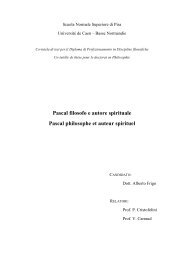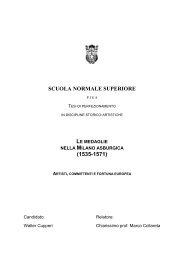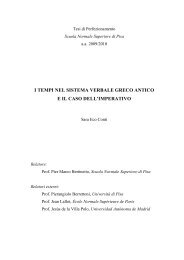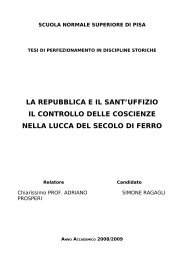CATULLUS 68 - Scuola Normale Superiore
CATULLUS 68 - Scuola Normale Superiore
CATULLUS 68 - Scuola Normale Superiore
Create successful ePaper yourself
Turn your PDF publications into a flip-book with our unique Google optimized e-Paper software.
COMMENTARY<br />
<strong>68</strong>A: A LETTER TO MANLIUS<br />
[Title] In each of the principal MSS O, G and R the scribe has left out a line above the poem. This space<br />
remains empty in O, but in G and R later hands (G 2 and R 2 ) have added the title Ad Mallium. McKie (1977:<br />
49-53) has shown that G 2 has taken his titles (and everything else) from m, which is a copy of R as modified<br />
by R 2 , that is, Coluccio Salutati. Consequently our only independent witness for the title Ad Mallium is R 2 .<br />
However, it cannot be ancient, as none of the titles above Catullus’ poems go back to antiquity (McKie 1977:<br />
75f. and Butrica 2007: 19-24 – the title given to poem 62 in the 9 th -century anthology T may constitute an<br />
exception, but that has no bearing on the titles in OGR). Ad Mallium must have been made up by somebody<br />
– but by whom, when, and why?<br />
No form of the name Mallius occurs in carmen <strong>68</strong> in O, G and R, which leads McKie (1977: 62) to conclude<br />
that “if the title has been invented from the text, the text at that time read malli and not mali” at lines 11<br />
and/or 30, that is, in this case the title would have been added to the pre-archetype V or to an earlier<br />
manuscript. It may well appear plausible that Ad Mallium should conserve the genuine form of the name of<br />
the addressee, which would have been corrupted at lines 11 and 30 mali. However, it is possible to turn this<br />
line of reasoning upside down. At lines 11 and 66 a marginal note was added to a manuscript at an earlier<br />
stage of the tradition (at line 11 to X or an earlier manuscript, and at line 66 to A or an earlier manuscript).<br />
The reader who added these notes (if we can attribute them to the same author) was clearly an intelligent<br />
person who knew his Latin well, and in fact we know that Catullus was read in the early 14 th century by<br />
humanists in Padua and Verona (see Thomson 1997: 24-27). This reader added forms of the name Manlius –<br />
but if he found a form of the name Mallius in the title of the poem, why did he not add that?<br />
In fact, the title can be accounted for in more ways than one. It could be a conjecture of Salutati’s, who was<br />
sufficiently erudite to know that Mallius was a good Roman name, unlike Malius; who was familiar with the<br />
tendency of the Northern Italian scribes responsible for the archetype and X to make double consonants<br />
single and vice versa; and who had just gone through poem 61, where he read mallio in the text in line 16<br />
(thus OGR) and above which he expanded the original title Epythalamus (sic!) to Epythalamus Junie et<br />
Mallii (see McKie 1977: 51 and 62f.). To be sure, in this case it has to be explained why this thorough and<br />
methodical man did not try to correct as much as possible of Catullus <strong>68</strong> and why he did not add a note such<br />
as al’ malli to his MS at lines 11 and 30. This might not be so surprising if he worked through his text more<br />
or less line by line, because reaching line 11 and finding in his exemplar X the marginal note al’ manli or<br />
mauli he may well have concluded that the name of the addressee may have been marred by more than a<br />
simple spelling error. Similarly, Mallium could be a conjecture by an earlier reader, though this hypothesis<br />
would raise the same objection as that of McKie, that if a correct Latin name was present in the title of the






